|
Harry Yourell was aboard Shark II. He was an Illinois State Legislator vacationing in the Bahamas on a fishing trip. The date was July 26, 1980. Several miles off the Exumas, they decided to come in closer to identify the islands nearby, seeking Staniel Cay. 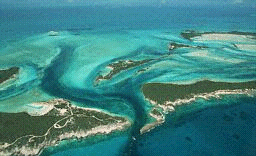 However, at a distance they saw a drifting sailboat. However, at a distance they saw a drifting sailboat.
An aerial shot of one of the many cays and islands of the Exumas chain. They stretch for a hundred or more miles on the shallow Great Bahama Bank, surrounded in a halo of aquamarine waters.
As they coasted around her stern to identify the sailboat, her dinghy drifted out from behind her starboard side. In it was the dead body of a man, naked from the waist up, covered with blood, with the bottom half “wrapped in something blue.” The head and arms were hanging over the stern into the water. A foul stench permeated the area.
Yourell shot 16mm film of the site and took still pictures of the dinghy and body. Since they were able to identify the small island as Pipe Cay, they realized they weren’t far from their destination of Staniel Cay. Upon arrival Yourell informed islander Ken Rolle of what they had found.
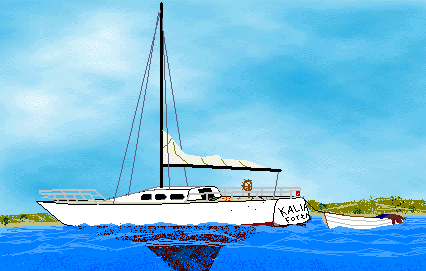
The gruesome sight of 38-foot Kalia III as Harry Yourell must have seen it on July 26, 1980.
Rolle put in a call for BASRA (Bahamian Air Sea Rescue Association) over his CB radio. Yet the message was 5 days in prompting a response! In the interim, Rolle went to the deserted cay himself. He went aboard and dropped the anchor in the sandy shallow bottom and noticed the foul looking body in the lazily bobbing dinghy. The body was still in the same position, hanging over the stern, impossible to identify.
The US Coast Guard informed the Bahamian Government that a 38-foot sailboat was missing. The occupants were author/electrician, William Kamerer and his wife, Patty.
Finally on July 31st, at 5:20 p.m., 50 minutes after the police were finally notified, agents (DC 1125) Lundy and Pratt (DC 616) left CID headquarters, Nassau, to pick up a mortician and head for a reserved chartered plane.
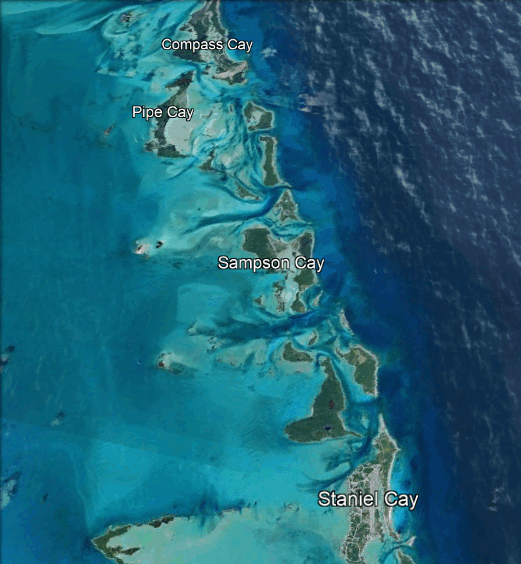
Staniel Cay in relation to Pipe Cay. It is a halfway point for those sailing the Bahamas, and it is dubbed “the quintessence of unaffected island retreats.” It has several natural attractions. Nearby is “Thunderball Cave,” so named after the 1965 James Bond movie filmed here. It is a grotto for snorkelers and divers alike. Some consider it more beautiful than the emerald waters of Amalfi in Italy. However, it is far more isolated, located in one of 3 tiny islets between Staniel and Big Major Cays. 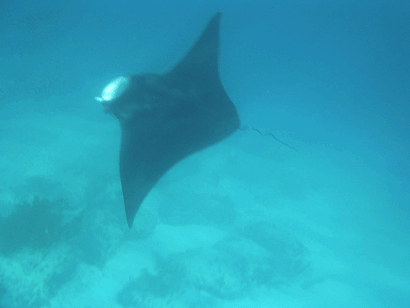
A manta ray, another of the exotic attractions of the shallow Exumas. (Courtesy Bimini Brown)
There was now a delay. The plane was not ready. They had to wait until 7:15 p.m. They were now at a disadvantage. Staniel Cay’s airport had no lighting facilities for night landing and takeoff. In such an instance the pilot could not wait for them; they would have to stay over night. The mortician opted not to go, so he gave his body bag to Lundy and Pratt but kept his chemicals.
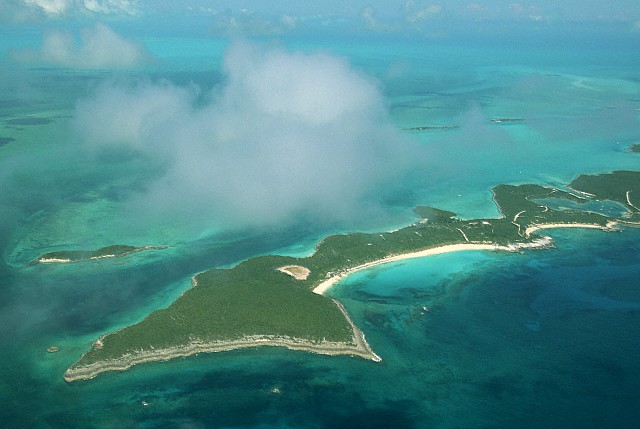
Above, Rudder Cut Cay reveals some of the beauty of the Exumas. (Source: Corbis, used under license.)
So, finally, at 7:40 p.m. the isolated Kalia III was no longer alone. Overhead in the droning plane, detective constables Lundy and Pratt were staring down on it. From this angle, the white Kalia III easily stood out, bathed in the amber sparkles on the ocean, reflecting the setting sun. The body was easily identifiable in the dinghy. “It appeared to be badly swollen to an abnormal size, and discolored. The lower part was ‘wrapped in something blue.”
They soon landed at Staniel Cay. There they met Ken Rolle and listened to his story. He told them he would take them to the spot; it would only take 25 minutes. However, they encountered another delay. With the sun setting, there would not be enough time to get the body before dark and takeoff for Nassau. Considering its stench, they did not wish to tow it to Staniel Cay and offend the guests and locals. Judiciously, it was decided to do nothing. Rolle assured them that the Kalia III was protected from the windward side by Pipe Cay. “It would take a very strong wind to overturn the dinghy.” It seemed the best thing was to leave it in the isolated Pipe Cay area. Relieved, Lundy and Pratt went back to Nassau. They would scoop up the mortician in the morning and be back.
Next morning Lundy, Pratt, Rolle, and the finicky mortician headed for the yacht. Upon boarding the sailboat they noted every clue. The report follows:
They decided to check the sailboat and saw no one. There were apparent blood stains in the pilot area of the stern of the boat and what appeared to be gun shot marks on the left side of the stern of the boat. There were also what appeared to be bullet holes in a red two gallon tin which was tied to a rail on the right side of the boat’s stern.
Two spent flare cartridges and four live flares were found at the stern of the boat. The flare gun was not found. A pair of glasses with brown frames was found on the deck of the stern. In the galley there were apparent blood stains.
The dinghy, however, was now suddenly empty!
There was a small amount of water in the bottom of the dinghy and on its right side were apparent blood stains. There was a large amount of maggots on the right side.
The US Coast Guard’s suspicions proved to be correct. The passports of William and Patty Kamerer were found in the galley. The log also showed they had been sailing the Bahamas “from north to south for several days.” The last entry was for the 25th of July, only a day before the Shark II came upon the scene. This was written in the hand of Patty Kamerer. The log also confirmed they left Fort Meyers, Florida, on the 28th of April.
Although the beaches of Pipe Cay were scoured for the body and the “blue wrapping,” nothing was ever sighted. The police boat Exuma finally towed the Kalia III to Nassau.
Soon international pressure came to bear on the Bahamian Government concerning an alleged cover-up. Yourell wasn’t happy at the lack of results. He was sure they were murdered by drug-running pirates. He accused the Bahamian 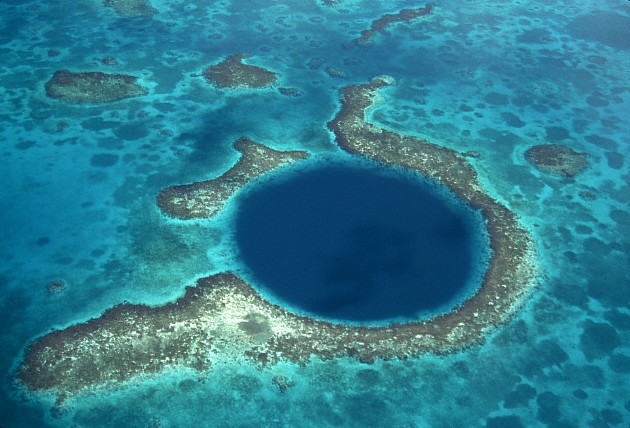 Government of improperly investigating the case because admitting modern day pirates still sailed the seas would hurt tourism. Circumstances only favored Yourell’s accusations. It seemed absurd that the body should suddenly vanish overnight. But it does seem to be a genuine coincidence. Government of improperly investigating the case because admitting modern day pirates still sailed the seas would hurt tourism. Circumstances only favored Yourell’s accusations. It seemed absurd that the body should suddenly vanish overnight. But it does seem to be a genuine coincidence.
An exotic “Blue Hole.” (Source: Corbis, used under License.)
On October 28, 1980, the Government of the Bahamas finally released a report, the whole purpose of which seemed designed to exonerate the police for losing the body. The report, from which the information on this web page is taken, was couched in the language of officialdom, and entitled: “Report on the Investigation of the disappearance of William and Patricia Kamerer on Yacht Kalia III— foul play is suspected.”
But the report was hardly that on an investigation. It merely placed a sequence of events in place without once attempting to connect or explain any clues or draw any deduction or induction from them. No insights were offered and only one deduction was made: that their murders may have been the result of drug smuggling, although it quickly added: “but there is no hard evidence that it is.” made: that their murders may have been the result of drug smuggling, although it quickly added: “but there is no hard evidence that it is.”
It’s largely because Harry “Bus” Yourell (right) made a stink about piracy that the Bahamas released a report. (uncredited photo)
On its own, however, the report does inadvertently finger the police’s gross inefficiency. It took five whole days for Nassau to even get the message. Lundy and Pratt may have been correct in not bringing the rotting corpse to Staniel Cay that night, but there was enough time for them to go look and examine the conditions and body. Moreover, by October the boat had been in police hands nearly 3 months, yet “apparent” blood stains and “apparent” bullet holes had not been confirmed, though it would have been easy to do so. There is no mention of the trajectory of the bullets. There is even no mention if the sails of the Kalia III were set, though this is an excellent indication of its last direction under control; nor if the gas tank was empty, which would plainly indicate the vessel was under motor, thus possibly motoring to an anchorage; nor if the throttle was engaged, a conclusive indication the yacht was under motor. Thanks to Rolle, we know the boat had not yet anchored, for he cast the anchor to secure the boat from drifting.
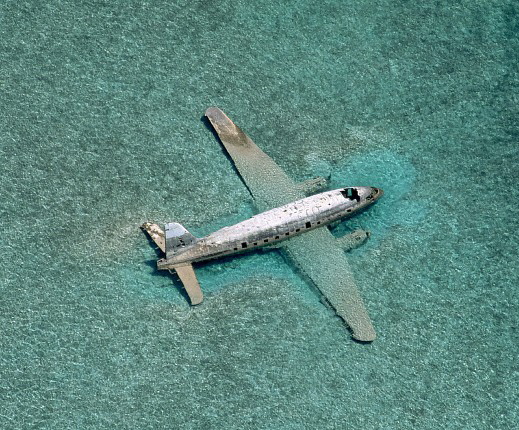 |
A drug-running DC-3 forced down in the Exumas. (Source: Corbis, used under License.)
The police scenario was that the Kalia III ventured into the Pipe Cay area, and there they may have stumbled upon a drug smuggling exchange. They are then shot. This does not really explain why the assailants would shoot-and-run, leaving the vessel as proof something happened. Locals know how long it takes the police to get out there. The drug smugglers would not have been in a hurry.
Bullet holes “apparently” were found in a tin on the right side, but nowhere does it say which side they entered. We must assume the left, since “apparent” bullet holes were found on the port side. These bullets must have sailed over the deck and missed Bill Kamerer as he stood nearby at the helm. The report does not even infer they were shotgun pellet holes, though some have later claimed the bullet holes were caused by shotgun blasts.
I would suggest this scenario:
1) On the night of July 25, 1980, William and Patty Kamerer were shot by persons unknown for unknown reasons. Patty Kamerer was knocked over by the blast of one of the gun shots. Bill Kamerer, piloting the yacht, was fatally wounded (possibly without knowing it). This explains the “apparent” bullet holes in the boat and the “apparent” blood at the stern deck, where he must have been at the wheel.
2) The vessel carrying the assailants immediately left, explaining why Kamerer was not finished off.
To explain the other clues, the following hypothetical chain of events is offered.
3) William Kamerer, wounded, went into the galley to get flares, thus explaining the blood in the galley. The first thing on his mind was to get his wife who was out in the water in the darkness (probably already dead). Thus there had been no MAYDAY. He went upon deck and fired off the flares in quick succession, not only as an SOS but to illuminate the sea to spot Patty. He was not dressed at the time of the incident, so he wrapped something “blue” around his waist (or had wrapped himself in it when they saw another boat). He climbed into the dinghy to get Patty, taking the flare gun with him to fire off more. In this state he died, the arm with the flare gun hanging over the side where his hand let it fall to the ocean bottom.
This can explain the known facts— specifically, why Patty Kamerer was not found and why, most curiously, a body was found in the dinghy and not on the sailboat. It also accounts for the location of blood, the spent flares, a missing flare gun, and why, in the shock of the moment, Kamerer sent no SOS but boarded the dinghy . . . there only to die.
This is, of course, only an explanation of the clues, not of the incident, which is, some 20 years later, still shrouded in mystery.
The above was first written by me in 1999. As I switched sites and this website grew to include many topics, I removed it. It is here restored February 27, 2024. The purpose to set the facts in order. Much has been promoted in the last 15 years, which has only served to spread error.
The information containing the report was released to me from the Department of Archives, Nassau, Bahamas, on April 29, 1992, under the direction of D. Gail Saunders (Ph.D), Director of Archives.
|
